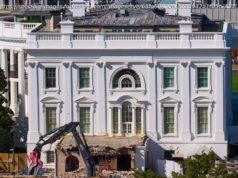With Democrats now in control of the House, President Donald Trump faces a tough test of whether he can forge compromises with a group of lawmakers who, he had warned his supporters, would wreck the U. S. economy.
WASHINGTON — With Democrats now in control of the House, President Donald Trump faces a tough test of whether he can forge compromises with a group of lawmakers who, he had warned his supporters, would wreck the U. S. economy.
The president on Wednesday floated the possibility of agreements with Democrats to boost spending on America’s infrastructure and to limit drug prices. Yet the poisonous atmosphere in Washington, mandated federal spending limits and a potential duel over the government’s borrowing authority make it difficult to forge any deals that would boost growth.
Over the next two years, most economic and market analysts foresee mainly entrenched gridlock in Congress. Many think the two sides will mostly maneuver for public favor while looking toward the 2020 presidential election year.
At a news conference Wednesday, Trump reiterated his desire to forge some agreement on infrastructure spending — to rebuild roadways, rail stations or airports, for example — among other priorities. But to achieve any real breakthrough, he would have to compromise with Democrats who won office largely by opposing his plans to restrict immigration, his efforts to repeal the Affordable Care Act, his deficit-funded tax cuts and his opposition to gun control in the aftermath of mass shootings.
That said, most economists don’t think a stalemate in Congress would necessarily depress growth. The $20 trillion U. S. economy — the world’s largest — relies far more on the health of the global economy and the willingness of consumers and businesses to spend rather than on any government actions.
Nor do market analysts think stock prices will suffer. In fact, major stock averages soared Wednesday in the wake of the elections. In part, that’s because Tuesday’s vote caused no major surprises, in part because the prospect of little or no major congressional initiatives means lawmakers won’t stand in the way of a robust U. S. economy.
“While you might see further gridlock if the Democrats take the House, that doesn’t mean it would tip the boat and slow growth,” said Beth Ann Bovino, chief U. S. economist at S&P Global.
Economists at Bank of America concluded, “We expect a divided government to lead to a legislative logjam in Washington, DC in the next Congress, limiting policy actions to passing the budget with modest spending increases and raising the debt ceiling.”
The new Democratic-led House could thwart Trump’s plans for more tax cuts, a wall along the border with Mexico and a 5 percent budget cut to Cabinet department. But the Democrats’ own agendas would also likely meet with defeat.
At his news conference, the president suggested that he could work with Democrats on such priorities as boosting infrastructure spending and reducing the costs of prescription drugs.
But Trump made clear that if House Democrats pursue him with investigations involving his 2016’s connection to Russia or financial ethics allegations, he would drop his willingness to seek cooperation on legislation involving the economy or other issues.
“They can play that game, but we can play it better,” the president said.
Still, Trump could be pressured to bargain with the Democrats on two major fiscal issues with consequences for the economy, said Joe Brusuelas, chief economist at the consultancy RSM.
The president would need to increase the government’s borrowing capacity — or it would be unable to continue issuing debt and possibly shutter. A 2011 showdown on the debt ceiling led the S&P 500 stock index to plummet and raised fears that the economy could sink into a recession.
“Given the new configuration of power in Washington, the probability of a government shutdown is greater than 50 percent,” Brusuelas said.
Second, Trump would need to sign a spending bill for fiscal 2020. Otherwise, previously agreed-upon spending caps would automatically reduce federal expenditures, which would likely slow the economy during a presidential election year.
The economy has enjoyed an acceleration in growth this year — to a gain estimated to be 3 percent. Unemployment is at a five-decade low of 3.7 percent, and employers are posting record-high job openings. The economy’s expansion is already the second-longest on record.
But annual growth is widely expected to dip back to its long-term average near 2 percent by 2020. It’s even possible the economy could slip into a recession within a few years as growth stalls — for reasons unrelated to who controls the White House or Congress. A global slowdown could, for example, spill into the United States. Or higher interest rates, spurred by the Federal Reserve, might depress economic activity.
Trump would still have discretion on some key economic issues. His trade war with China and his drive to reduce regulations are two of them. The president has managed to pursue those priorities without Congress’ involvement, though his updated trade agreement with Canada and Mexico would need congressional approval.
In an appearance last month at Harvard University, Pelosi, outlined her agenda should her party regain the chamber’s majority and she the speakership. Within the first 100 days, Pelosi said, she would seek to reduce the influence of large campaign donors and groups that aren’t legally required to disclose their funding sources. She would also pursue infrastructure funding and seek protections for undocumented immigrants who came to the United States as children, among other priorities.
Yet the rancor between the two parties makes the likelihood of any meaningful economic measures appear dim.
“The way parties are talking about it right now, I don’t think anybody is dying to cooperate,” said Michael Madowitz, chief economist at the Center for American Progress, a liberal think tank.






